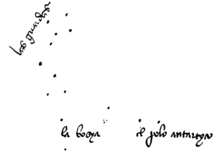Crux
Even though it is the smallest of all 88 modern constellations, Crux is among the most easily distinguished as its four main stars each have an apparent visual magnitude brighter than +2.8.Crux also contains the bright and colourful open cluster known as the Jewel Box (NGC 4755) on its eastern border.However, the precession of the equinoxes gradually lowered the stars below the European horizon, and they were eventually forgotten by the inhabitants of northern latitudes.Dante may have known about the constellation in the 14th century, as he describes an asterism of four bright stars in the southern sky in his Divine Comedy.Faras sketched and described the constellation (calling it "las guardas") in a letter written on the beaches of Brazil on 1 May 1500 to the Portuguese monarch.[11] Another early modern description clearly describing Crux as a separate constellation is attributed to Andrea Corsali, an Italian navigator who from 1515 to 1517 sailed to China and the East Indies in an expedition sponsored by King Manuel I.[2] Crux is bordered by the constellations Centaurus (which surrounds it on three sides) on the east, north and west, and Musca to the south.Crux is easily visible from the southern hemisphere, south of 35th parallel at practically any time of year as circumpolar.Projecting a line from γ to α Crucis (the foot of the crucifix) approximately 4+1⁄2 times beyond gives a point close to the Southern Celestial Pole[3] which is also, coincidentally, where intersects a perpendicular line taken southwards from the east–west axis of Alpha Centauri to Beta Centauri, which are stars at an alike declination to Crux and of a similar width as the cross, but higher magnitude.The four or five brightest stars of Crux appear, heraldically standardised in various ways, on the flags of Australia, Brazil, New Zealand, Papua New Guinea and Samoa.Songs and literature reference the Southern Cross, including the Argentine epic poem Martín Fierro.The 1952-53 NBC Television Series Victory At Sea contained a musical number entitled "Beneath the Southern Cross".In India, there is a story related to the creation of Trishanku Swarga (त्रिशंकु), meaning Cross (Crux), created by Sage Vishwamitra.In Aranda traditions of central Australia, the four Cross stars are the talon of an eagle and Gamma Centauri as its leg.This aquatic theme is also shared by an archaic name of the constellation in Vietnam, where it was once known as sao Cá Liệt (the ponyfish star).[45] Among Filipino people, the southern cross have various names pertaining to tops, including kasing (Visayan languages), paglong (Bikol), and pasil (Tagalog).[47] The Southern Cross (α, β, γ and δ Crucis) together with μ Crucis is one of the asterisms used by Bugis sailors for navigation, called bintoéng bola képpang, meaning "incomplete house star"[48] The Māori name for the Southern Cross is Māhutonga and it is thought of as the anchor (Te Punga) of Tama-rereti's waka (the Milky Way), while the Pointers are its rope.[51] Alpha and Beta Crucis make up one foot of the Great Rhea, a constellation encompassing Centaurus and Circinus along with the two bright stars.[53] The Kalapalo people of Mato Grosso state in Brazil saw the stars of Crux as Aganagi angry bees having emerged from the Coalsack, which they saw as the beehive.








Crux (disambiguation)Southern Cross (disambiguation)List of stars in CruxGenitiveRight ascensionDeclinationMain starsFlamsteedplanetsMessier objectsMeteor showersCentaurusconstellationsouthern skyasterismMilky Waysmallest88 modern constellationsapparent visual magnitudeα Crucisβ Crucisγ Crucisδ Crucisε CrucisScorpius–Centaurus associationCepheid variablesopen clusterJewel Boxdark nebulaCoalsack NebulaAncient GreeksPtolemyBritainprecession of the equinoxesDivine ComedyJoão FarasAlvise CadamostoGambia RiverAmerigo VespucciAndrea CorsaliEast IndiesKing Manuel IEmery MolyneuxPetrus Planciusuranographerscelestial globeJodocus HondiusFrederick de HoutmanJakob BartschAugustin RoyerInternational Astronomical UnionEugène Delporteequatorial coordinate system25th parallel northCassiopeiaCape TownAdelaideBuenos Aires34th parallel southFalse CrossDiamond CrossIC 2944southern hemispheretropical latitudesnorthern hemisphereCancunprecessionnavigationPolarisAlpha CentauriBeta CentauriArgentinegauchosPampasPatagoniathat shine the brightest as viewed from the Earthapparent magnitudemagnitudeBeta Cepheivariable stardouble starred giantsIota CrucisMu CrucisOB associationLambdavariable starsBG CrucisT CrucisS CrucisR CrucisLambda CrucisTheta2 CrucisBH CrucisMira variableHD 106906HD 106906 bScutum-Centaurus ArmparsecsJohn Herschelblue supergiantsred supergiantKappa CrucisFlags depicting the Southern CrossAustraliaBrazilNew ZealandPapua New GuineaAustralian state of VictoriaAustralian Capital TerritoryNorthern TerritoryMagallanes Region of ChileLondrinaTierra del FuegoSanta CruzMercosurBrazilian coat of armsBrazilian passportsCruzeiro Esporte ClubeOrder of the Southern CrosscruzeiroBrazilian realNational Order of the Southern CrossMartín FierroCharly GarcíaBrazilian National Anthem